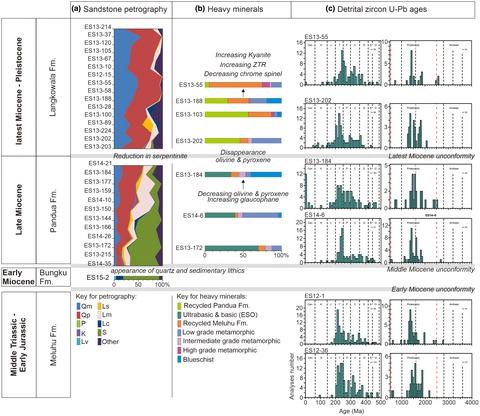当前位置:
X-MOL 学术
›
Basin Res.
›
论文详情
Our official English website, www.x-mol.net, welcomes your feedback! (Note: you will need to create a separate account there.)
Neogene sediment provenance and paleogeography of SE Sulawesi, Indonesia
Basin Research ( IF 3.2 ) Pub Date : 2022-05-11 , DOI: 10.1111/bre.12682 Abang Mansyursyah Surya Nugraha 1, 2 , Robert Hall 2
Basin Research ( IF 3.2 ) Pub Date : 2022-05-11 , DOI: 10.1111/bre.12682 Abang Mansyursyah Surya Nugraha 1, 2 , Robert Hall 2
Affiliation

|
Neogene syn-and post-orogenic sedimentary rocks in Sulawesi are important to understand the history of collision of Australian continental crust with SE Asia. However, they have received relatively little attention, and have generally been considered to be molasse-type deposits of similar characteristics across Sulawesi—the Celebes Molasse. New field sedimentological observations, results from heavy mineral studies and detrital zircon U–Pb geochronology, together with conventional sandstone petrography identify three important provenance shifts, that can be correlated with significant tectonic events and enable the reconstruction of the Neogene palaeogeography of SE Sulawesi. The first provenance shift was related to the Early Miocene collision of Australian crust and the North Sulawesi volcanic arc, accompanied by ophiolite emplacement in East Sulawesi, marked by a change from pre-collision carbonates to ultramafic-rich clastics of the Bungku Formation. A second change in the Late Miocene was marked by input of abundant metamorphic detritus including blueschists into the Pandua Formation indicating exhumation of Oligo-Miocene subduction zone material. The third provenance change, of Mio-Pliocene age, was from the ophiolite- and blueschist-rich Pandua Formation to the quartz-rich Langkowala Formation, and records blocking of the ophiolite debris pathways by the rise and progressive unroofing of low- to high-grade metamorphic rocks. The Neogene sedimentary rocks of SE Sulawesi record Early Miocene collision and ophiolite emplacement, followed by extension which led to exhumation of Mesozoic and metamorphic rocks, driven by Banda subduction rollback.
中文翻译:

印度尼西亚东南苏拉威西岛新近纪沉积物物源和古地理
苏拉威西岛的新近纪同造山和造山后沉积岩对于了解澳大利亚大陆地壳与东南亚的碰撞历史具有重要意义。然而,它们受到的关注相对较少,通常被认为是整个苏拉威西岛具有相似特征的糖浆型矿床——西里伯斯糖浆。新的现场沉积学观测、重矿物研究和碎屑锆石 U-Pb 地质年代学的结果以及常规砂岩岩相学确定了三个重要的物源变化,这些变化可以与重要的构造事件相关联,并能够重建 SE Sulawesi 的新近纪古地理。第一次物源转移与早中新世澳大利亚地壳和北苏拉威西火山弧的碰撞有关,伴随着东苏拉威西的蛇绿岩就位,其标志是从碰撞前的碳酸盐岩转变为 Bungku 组的富含超镁铁质的碎屑岩。晚中新世的第二个变化是大量变质碎屑(包括蓝片岩)进入 Pandua 组,表明寡-中新世俯冲带物质的折返。中新世第三次物源变化是从富含蛇绿岩和蓝片岩的 Pandua 组到富含石英的 Langkowala 组,记录了低至高位的上升和逐渐开顶阻塞了蛇绿岩碎屑通道。级变质岩。SE Sulawesi 的新近纪沉积岩记录了早中新世碰撞和蛇绿岩侵位,随后延伸导致中生代和变质岩折返,
更新日期:2022-05-11
中文翻译:

印度尼西亚东南苏拉威西岛新近纪沉积物物源和古地理
苏拉威西岛的新近纪同造山和造山后沉积岩对于了解澳大利亚大陆地壳与东南亚的碰撞历史具有重要意义。然而,它们受到的关注相对较少,通常被认为是整个苏拉威西岛具有相似特征的糖浆型矿床——西里伯斯糖浆。新的现场沉积学观测、重矿物研究和碎屑锆石 U-Pb 地质年代学的结果以及常规砂岩岩相学确定了三个重要的物源变化,这些变化可以与重要的构造事件相关联,并能够重建 SE Sulawesi 的新近纪古地理。第一次物源转移与早中新世澳大利亚地壳和北苏拉威西火山弧的碰撞有关,伴随着东苏拉威西的蛇绿岩就位,其标志是从碰撞前的碳酸盐岩转变为 Bungku 组的富含超镁铁质的碎屑岩。晚中新世的第二个变化是大量变质碎屑(包括蓝片岩)进入 Pandua 组,表明寡-中新世俯冲带物质的折返。中新世第三次物源变化是从富含蛇绿岩和蓝片岩的 Pandua 组到富含石英的 Langkowala 组,记录了低至高位的上升和逐渐开顶阻塞了蛇绿岩碎屑通道。级变质岩。SE Sulawesi 的新近纪沉积岩记录了早中新世碰撞和蛇绿岩侵位,随后延伸导致中生代和变质岩折返,



























 京公网安备 11010802027423号
京公网安备 11010802027423号